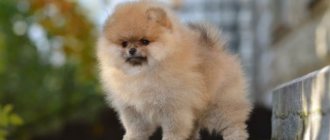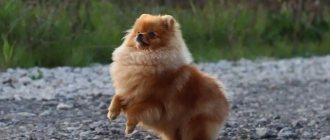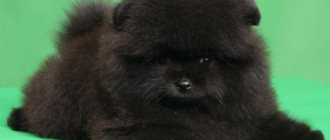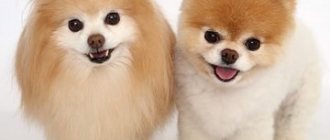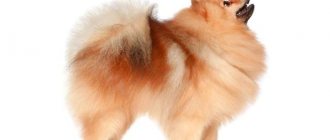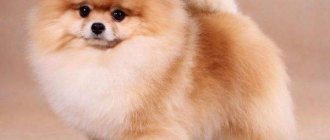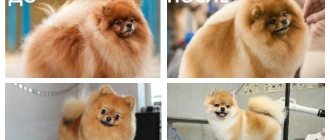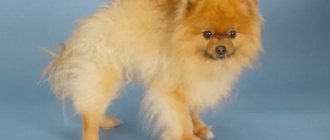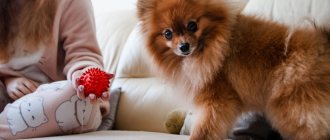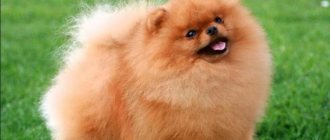There are a sufficient number of animals in the world that will not leave anyone indifferent. Among dogs there are also many breeds that conquer the hearts of people from the first meeting. A miniature dog with plush fur, a bear-type Pomeranian. This variety is similar to a soft toy. However, any pet requires care and attention. Before you get a cute pet, you should understand the intricacies of keeping a Pomeranian.
Appearance
The fact is that the bear type is not a separate species from the Pomeranian. In essence, there is no difference between them. Subspecies appeared as a result of a long period of breeding: fox, bear and baby buck. The fox-faced Pomeranian is considered standard. The name “bear type” is associated with the characteristics of the individuals’ heads.
— Advertising —
The Bear Spitz has a round head, the muzzle is slightly flattened and shortened. The eyes are round, close together, and the tip of the nose is slightly raised.
These are tiny dogs. As a rule, they weigh from 2 to 3 kg, and the height at the withers ranges from 12 to 28 cm.
The rest of the body looks the same for all types.
— Advertising —
Animals have a strong constitution. The dog has a short and straight back. The tail is bushy, set high, and lies flat and straight on the back.
The chest is wide and well developed.
The forelimbs are straight, the shoulder blades are long. The paws are rounded, with black soft pads. The hind limbs are muscular and run parallel to each other.
The pet's coat is usually thick and has a double layer. It is known that the top layer is rough, and the inner layer is smooth and delicate.
The dog comes in different colors. These include: white, cream, brown, black, sable, orange, tan, chocolate, gray and so on.
Not many people know that the animals are miniature versions of the large sled dogs of the Arctic.
Such different Pomeranians
In the modern world, Pomeranians are divided into three types:
Adult weight does not exceed 3 kg
- The fox face type is the usual German Dwarf Spitz. The length of the Spitz's muzzle to the size of the head is equal to the proportion of 2:3. The size of the muzzle is 2-3 cm.
- Bear type - the dog's muzzle is shorter, the lower jaw is wider than that of the fox type. The tip of the nose is turned up. The head is round, and the dog has a lot of hair on the cheekbones, which creates the effect of cheeks. The size of the muzzle is 1 cm.
- The doll type is a rare species for Russia. The flat muzzle, large forehead, and low-set eyes make this type of Spitz look like a doll.
Pomeranians have different head shapes that separate the breed, but that is the only difference. Otherwise, mini-dogs are similar in all breed characteristics. The weight of an adult orange is about 3 kg.
The popularity of bear orange is due to its appearance. These cute pets look like a teddy bear, their small size and cheerful disposition captivate people all over the world.
Pros and cons of a dog
Pros of the type:
- The Pomeranian bear cub has an optimistic character.
- They are ideal companion dogs that require a lot of attention from their owners. In return, the Pomeranian gives love and affection to its family.
- Pets love to participate in everything that happens around them.
- Despite their small size, Pomeranians are active and prefer long walks.
- Spitz are very vigilant and have a highly developed protective instinct. They make good watchdogs that will always warn their owners with loud barks.
- Animals are suitable for families with adult children and elderly people.
- Pets are smart and learn quickly. The only difficulty may be the species' addiction to dominance, but this can be easily avoided with proper upbringing from early childhood.
- Dogs get along well with other pets.
Disadvantages of the type:
- Potential owners must be prepared and patient during Pomeranian obedience training.
- The breed should not be owned by families with small children. Kids may miscalculate their strength and choke their pets.
- Pomeranians love to bark. This can be a problem for owners who live in an apartment.
- Animal fur requires daily care.
- They shed a lot.
- Birds such as eagles, hawks and owls will happily fly away with a Pomeranian in their talons. You will need to constantly supervise your little Pomeranian while he is playing outside.
- The dog cannot stand loneliness. Therefore, if all family members leave home for more than seven to eight hours, then this dog is not for you.
Love for walks
The Mini Spitz loves to go for long walks. Long walks for the breed are not necessary, but dogs are very useful for health and maintaining enthusiasm. Spitz dogs run easily and naturally on the snow, earth or green grass, their small legs are almost invisible from under their thick fur coat. From a distance it seems that these snow-white, tar and red balloons are floating not far from the ground. For praise and approval, the Pomeranian is capable of performing the most unexpected tricks. Jumps, flips, games of catch - everything is to the liking of the little furry.
History of the origin of the breed
The breed was developed in Pomerania, Germany. The Pomeranian Spitz has served man with devotion for more than four hundred years. Initially, this animal was used as a watchman and shepherd. Then the dog weighed on average 13-14 kg.
At the end of the 19th century, a miniature version of the breed gained popularity. Her weight was about 4-5 kg. This reduction in body weight is associated with the British Queen Victoria, who was a fan of the species. But the dogs she kept were many times smaller than the then common size.
Over time, these kids became real friends and companions of people. There are many great names associated with this breed. For example, Mozart. The great composer dedicated one of his works to his favorite. Frederic Chopin wrote "Waltz of the Dog" while his little friend was chasing his own tail.
In England, the breed standard was written at the end of the 19th century. Later, the species was recognized by the American Kennel Club. This happened in 1900.
Nowadays, this breed is used to treat stress and depression in people in Europe. The owner can take the pet with him always and everywhere due to its light weight.
Lifespan
Compared to many miniature breeds, Pomeranians live a long time - 11-15 years.
In some cases, dogs reach 20. To do this, it is necessary to feed the pet properly, maintain a healthy lifestyle, and protect it from diseases typical of Spitz dogs. With proper care, Pomeranians do not get sick and remain active until old age.
Kinds
Mini or dwarf
Miniature or dwarf Pomeranians are charming creatures that thrive in apartments. The individual has a standard appearance and a very compact body. The pet has fur that is fluffy and dense to the touch, and comes in many different colors. The dog's head is small, round in shape, expressive eyes, small ears.
Many people are interested in how much does a dwarf Spitz cost? The price of a puppy from a good professional nursery varies from $500 to $1000.
Classic animals of standard or mini sizes are the best choice for home keeping. Such dogs are not too whimsical and do not require such careful care as, for example, the bear type.
Maintenance and care
Many people are interested in how to properly care for a bear-type Pomeranian? Caring for the breed is not difficult, but it has some peculiarities.
- The main pride of these animals is their luxurious wool. Brush them twice a week. A more frequent procedure may leave your pet without undercoat.
- An adult bear-type Pomeranian does not need frequent bathing. Wash it before exhibitions, in cases where it gets wet during a walk and during heavy shedding. Brush your pet thoroughly before bathing.
- The weak point of dwarf breeds is often their teeth. Clean them with specially designed brushes. This is necessary to prevent periodontitis.
- Periodically wipe your eyes with damp swabs, which can be moistened with plain boiled water.
- Visit your groomer periodically. However, in summer you should not cut the dog completely, as the coat helps the dog protect its skin from the scorching sun. You can ask a specialist to give your Pomeranian a bear haircut. Then he will look even cuter.
- Go to the vet every six months. He will create a vaccination schedule and also examine your pet for diseases. Periodically carry out deworming and flea prevention. Check your pet daily for ticks.
Do you need a haircut?
The main care for the coat of representatives of this breed consists of thorough combing. It is not necessary to trim Pomeranians; it is only necessary to give the dog a neater appearance.
A bear cut involves trimming stray guard hairs, giving the paw pads a “cat-like” shape, and trimming the ears to make them round. A Spitz cut this way looks neater.
CAREFULLY!
It is forbidden to shave or cut Pomeranians short - due to the tendency of these dogs to alopecia, their hair may not grow back after such a haircut.
Nutrition
There is one important thing you should remember throughout your dog's life - he needs a balanced diet. You should carefully read the label before purchasing food. The veterinary manual prescribes that the dog’s diet should provide a minimum protein content, namely 18% per day. Also a minimum fat content, namely 5% per day. It is important to find a food that contains omega fatty acids, vitamins and minerals. Avoid foods that contain a lot of chemical ingredients and dyes.
What kind of human food can you give to your pet?
You can also give Pomeranians human food. These include:
- Sources of protein. Chicken, turkey, lamb, fish, beef liver, chicken liver, pork, venison, shrimp, crawfish.
- Vegetables. Asparagus, beets, bell peppers, broccoli, cauliflower, carrots, cucumber, green beans, cabbage, spinach, lettuce, peas, potatoes, zucchini.
- Carbohydrates. Porridge, pasta.
- Natural fats. Sunflower seeds, peanut butter, peanuts, flaxseeds, cashews.
- Other products. eggs, cottage cheese, cheese, honey, apples, banana, blueberries, melon, kiwi, oranges, nectarines, peaches, pear, pineapple, plums, pumpkin, mango, raspberries, strawberries.
Avoid giving your Pomeranian the following foods frequently: bread, crackers, coconut, popcorn, potato chips, marshmallows, bacon, pancakes, waffles. They may upset your friend's digestion.
Never feed Pomeranians the following foods: onions, garlic, chocolate, grapes (including juices, jams and jellies), raisins, currants, cinnamon, mushrooms, pecans, walnuts, macadamia nuts, cherries (and other small-seeded fruits) or seeds), yeast dough.
An adult Spitz should consume the following amounts of food per day, depending on weight and activity:
- 1 kg – from 24 to 31 g.
- 1.5 kg – from 32 to 42 g.
- 2 kg – from 40 to 53 g.
- 2.5 kg – from 47 to 62 g.
Pomeranians burn calories much faster than some other breeds. This is due to their small size and high activity level. Divide your pet's food into three or four meals per day. This will help the animals continuously produce the required level of energy.
Girl
Many people have the preconceived idea that a female Pomeranian is superior to a male. However, it is not.
They are difficult to distinguish by appearance. The most obvious sign is the genitals of individuals. Some breeders try to find out the sex of the newborn right away. However, even experienced specialists sometimes confuse the umbilical cord with the male genital organs. Therefore, it is possible to determine the gender correctly only after babies reach 3-4 weeks.
An adult girl is usually a little larger than a boy, but this is all individual.
The main thing to remember is that character and temperament depend solely on the individual. In general, girls are playful, funny, and loyal.
One of the inconvenient moments when keeping females is estrus, which occurs several times a year. At this time, the bitch will attract all the males in the area, which can make walking difficult. The female's first estrus occurs when she reaches the age of 6 to 10 months. You can sterilize her, as unsterilized girls are more bossy and capricious.
How to choose your future pet?
It is better to purchase a dog from a specialized nursery. It is necessary to inspect the living conditions of the dogs, meet the parents of the future pet, find out about their health, and ask the breeder for a veterinary passport with notes on vaccinations and deworming.
Watch the puppy. A healthy baby should be active, cheerful, and inquisitive. He should have a shiny coat without dandruff or bald patches, clean skin without rashes or irritations. The baby should not have any discharge from the eyes or ears.
You should buy a dog only after it is 4-5 months old - only at this age can you determine its color and whether it belongs to a certain type.
Boy
Male dogs are more independent than females. Therefore, it is very important to start obedience training from a very young age.
They tend to be less capricious and usually more affectionate than females.
One common complaint about male dogs that you hear most often is that dogs like to “mark” their territory and are difficult to toilet train. You should be tolerant and consistent in training your animal.
It is noteworthy that young puppies urinate the same way, regardless of gender. However, after 6 months, most male dogs will raise their leg while urinating, while female dogs will continue to squat.
Nicknames
For boy
Popular nicknames for boys:
- Prince.
- Lucky.
- Winston.
- Bentley.
- Luther.
- Little bear.
- Chester.
- Edmund.
- Sid.
- Teri.
- Albert.
- Monty.
- Maximilian.
- Mozart.
- Othello.
- Jupiter.
- Phoenix.
- Bean.
- Toby.
- Bertie.
- Callie.
For girl
Popular nicknames for girls:
- Izzy.
- Princess.
- Lei.
- Bella.
- Roxy.
- Esther.
- Athena.
- Foxy.
- Jessica.
- Janie.
- Gina.
- Massey.
- Mini.
- Marilyn.
- Molly.
- Stella.
- Button.
- Lily.
- Moon.
Breeding
A litter usually produces several puppies - from one to three. Breeders try to find parents by weight. It is necessary that the female weighs about 2.5 kg, and the male – 2-2.2 kg.
If the “lady” behaves aggressively towards the “knight”, then she is not yet ready for mating.
The fertilization period is individual for each animal, but usually the optimal moment occurs on days 11-13 of estrus. If everything went well, then on the 58-63rd day the babies are born.
The puppy weighs 55-125 grams at birth. Children are not removed from their nursing mother until they are two months old. They gain up to 10 grams of weight per day if well cared for.
Dog character
The dog is known to be friendly with everyone, and his training will be fun and easy thanks to his bright personality. The bear gets along well with children and other pets.
It should be noted that this breed can be a little aggressive towards other dogs if they feel competition.
Bear Pomeranians make excellent watchdogs as they are very vigilant. They also have the ability to sense danger or changes in the environment. Pets like to bark if they hear suspicious sounds. But barking can be controlled with proper training.
The puppy is very playful. So get him toys that will keep him occupied.
Another feature of the animal is that it likes to be the center of attention. Be sure to surround him with love, which the dog really needs.
Pomeranians are intelligent and eager to learn. Due to their active nature, they perform well as circus dogs. Pets also successfully act in films. However, consistent training is required to get the best out of them.
Choosing a puppy
Before you buy a puppy, you should check the documents of the Spitz's parents. Diplomas from the exhibition and pedigree can be viewed in the nursery. It is better to refrain from buying a puppy obtained from the first mating, because the dog could have inherited various defects.
Before purchasing a puppy, carefully check all accompanying documents
If the breeder cannot show the necessary documents for the sires, perhaps everything is not in order with the papers, such a puppy is not worth buying.
To buy a dog, you need to conclude a sales contract, which indicates the cost of the puppy. The purpose of purchasing a Spitz also affects the price, which means it’s worth writing about this in the contract. Documents that the breeder must have:
- Veterinary passport, which indicates the date of birth of the puppy, data on the owner. This document records the pet's vaccinations.
- Metrics for a puppy. It indicates the origin of the dog, color, gender of the puppy, as well as the number assigned to the animal. The cynological organization replaces the metric with the pedigree of the animal.
When the puppies run to look at the stranger, mark the bravest one. It is better to abandon a puppy that barks incessantly. A dog whose tail is between its legs is no longer a representative of the breed. Cowardice is a breed defect. An affectionate and active dog will be a great friend.
Pomeranian puppies
If the puppy meets all the criteria for a new owner, then all that remains is to examine the pet’s appearance. The tummy should not be bloated, the back should not sag. The paws should be level and straight.
Education and training
If you want your Pomeranian to be a wonderful companion, he must learn good manners from an early age. Let's consider the main points of education that are recommended for your little friend:
- Homeschooling.
- Obedience training.
- Workout.
As soon as you bring your puppy home, begin training and training for maximum benefit.
The pet is easy to train. It is enough to give a clear command or confidently prohibit an action. However, it should be remembered that the animal will often strive to dominate.
Spitz will happily follow commands that contain elements of dance or play. They will be less able to follow commands such as “sit.” Most likely, this is due to the dog’s increased activity. The animal's favorite command is “fetch.” This word comes from the French "apporter", which means to bring. The Spitz will happily run after an abandoned toy or bring the right thing. Also teach your baby other commands:
- "To me". You should not approach the animal when teaching it this command. Wait, it will understand and come to you on its own.
- "Near". Patience is required for effective absorption.
- "Ugh". When training a team, it is necessary to observe some nuances. For example, don't pull on the leash, yell, or use force.
- "Give". This command is easy to teach when using a ball.
The skills of going to the toilet need to be instilled from the first days. As you watch your puppy, you may notice some warning signs of the urge to relieve yourself. For example, before defecating, the pet will spin around and sniff everything in search of the right place. At this point, it is necessary to transfer it to the tray selected for defecation. Also put your puppy in it after sleep and after eating. Be sure to praise the animal when it performs the action independently and in the right place. Puppies usually quickly get used to eliminating in the litter box. The main rule for you is to be patient and calm.
Diseases
Here are some health problems that are common in Pomeranians:
- Injuries. One of the main causes of death of all individuals. Injuries may include: an accidental fall, being hit by a car or in an accident, trachea being crushed by a leash, and so on.
- Gastrointestinal problems. These include: constipation, inflammatory bowel disease (enterocolitis), pancreatitis, lymphangiectasia (dilation of the lymphatic vessels that are located in the submucosal and mucous layers of the wall of the small intestine), exocrine pancreatic insufficiency, and so on.
- Infections. Problems of this type include: fungal infections, viral diseases (distemper and parvovirus), bacterial infections (such as leptospirosis) and protozoal diseases (such as leishmaniasis and babesiosis).
- Allergy. It can appear under the influence of various factors: food, environment, medications, insects, and so on. If your pet develops symptoms such as sneezing, watery nose, red skin, and itching, contact your veterinarian.
- Separately, it is necessary to highlight the collapse of the trachea. The trachea, or breathing tube, is made up of rings of cartilage that make it look like the ribbed hose of a vacuum cleaner. This structure ensures its flexibility and strength. The cartilaginous rings of the breed are weak. The trachea can collapse and become too narrow due to external factors. This leads to coughing and difficulty breathing. Most cases of collapse are mild. They are treated with medications. When symptoms are severe, surgery is performed.
In any case, if you notice any changes in your dog's behavior or appearance, take him to the vet. Timely help will help cure and sometimes save your pet’s life.
Grooming to get a bear cub
If you want your pet to look like the “bear cub” from social networks, create his image with a good haircut. Specialists at the grooming salon will even out the length of the top coat and undercoat. A haircut on the muzzle will highlight the eyes, round and plump the cheeks. It is contraindicated to shave a dog during hot weather. Wool is a natural temperature regulator and protects the bears from overheating. If a dog is a participant in an exhibition, then it should not have a model haircut, the dog should look natural.
Interesting Facts
- Like Malamutes and Akitas, Pomeranians are a breed with wolf-like characteristics.
- Dogs have “Napoleon syndrome”, which is why they love to go on adventures. Animals think they are big dogs. Due to this, they often choose fights with larger species and boldly jump from high places.
- Famous people who own Pomeranians: Eva Longoria, Sylvester Stallone, LeAnn Rimes (she has three), Jessica Alba, Keanu Reeves, Gwen Stefani, Kate Hudson.
- The Japanese dog Shunsuke and the European dog Boo are the most popular bear-type Pomeranians in the world. The first dog has a Twitter account, the second one has a Facebook account. About a million people subscribe to them. Owners upload photos of their pets daily, delighting fans.
- Spitz have all sorts of colors in the standard - from white to black. This sets them apart from most other species. The most popular color is bright orange or red.
- The famous monk, theologian and church reformer Martin Luther was the owner of a Spitz. Whenever the man was not busy with his work, he was entertained by a cute little friend named Belferlein.
- The famous mathematician and physicist Isaac Newton had a Pomeranian named Diamond.
- Dogs graced the following films: “To Die For” (in the film a woman loves her dog more than her husband), “Harlem Nights” (the pet is the main character’s constant companion), “Cadillac Man” (a dog named Chester participates in the show), “ Enemy of the State", "Blade: Trinity", "Superman Returns", "Titanic".
- Among the bear-type Pomeranians there is also a hero. One day, an attacker broke into the home of an American family to rob. The pet grabbed the bandit's hand and did not let go, allowing its owners to call for help.
Extinct bears
The number of extinct bears is vague because the existence of one species is in question. There is a glimmer of hope that the Tibetan clubfoot still exists, although for a long time it has not been seen by people or captured by video cameras. If you see one, let the scientists know. The bear looks like a brown one, but the front part of the body is reddish. The animal's withers are almost black. In the groin area the fur is red. The rest of the fur on the back of the predator is dark brown. The bear lived in the east of the Tibetan plateau.
California grizzly
It appears on the California flag, but has not been found in the state or beyond since 1922. Then the last representative of the animal species was killed.
The bear had a golden fur color. The beast was a totemic animal among the Indians. The Redskins believed that they were descended from grizzly bears, so they did not hunt the ancestor. The white settlers exterminated the clubfoot.
Mexican grizzly
Officially declared extinct in the 60s of the last century. The animal was large, weighing approximately 360 kilograms.
The Mexican grizzly bear was distinguished by whitish claws on its front paws, small ears and a high forehead.
Etruscan bear
A fossil species that lived in the Pliocene. This geological period ended 2.5 million years ago. The second name of the predator is short-faced bear. This is the one with 13 pairs of ribs.
Skeletons of Etruscan bears are found only in southern latitudes. Therefore, scientists assume that the animal was heat-loving. It is also known that the extinct animal was large, weighing approximately 600 kilograms.
Atlas bear
Inhabited lands from Morocco to Libya. The last individual was killed by hunters in the 1870s. Externally, the animal was distinguished by reddish fur on the underside of the body and dark brown hair on top. There was a white spot on the bear's face.
Unlike most bears, the Atlas bear preferred desert and arid areas. The name of the species is associated with the chain of mountains where the clubfoot lived. Zoologists classified them as a subspecies of brown bear.
Giant polar bear
The appearance of the polar bear was similar to that of a modern one. Only the beast reached 4 meters in length and weighed 1200 kilograms. Such giants lived on the planet 100 thousand years ago.
So far, scientists have found the only ulna bone of a giant bear. The bone was discovered in Pleistocene sediments in Great Britain.
The survival of modern polar bears is also in question. The number of the species is sharply declining. This is due to climate change. Glaciers are melting. Animals have to make increasingly longer swims. Many predators reach the shore exhausted. Meanwhile, it is not easy for bears that are full of energy to get food in the snowy expanses.
